逻辑回归
比较好的逻辑回归博客:逻辑回归
本栏目(Machine learning)包括单参数的线性回归、多参数的线性回归、Octave Tutorial、Logistic Regression、Regularization、神经网络、机器学习系统设计、SVM(Support Vector Machines 支持向量机)、聚类、降维、异常检测、大规模机器学习等章节。所有内容均来自Standford公开课machine learning中Andrew老师的讲解。(https://class.coursera.org/ml/class/index)
第三讲-------Logistic Regression & Regularization
本讲内容:
Logistic Regression
=========================
(一)、Classification
(二)、Hypothesis Representation
(三)、Decision Boundary
(四)、Cost Function
(五)、Simplified Cost Function and Gradient Descent
(六)、Parameter Optimization in Matlab
(七)、Multiclass classification : One-vs-all
The problem of overfitting and how
to solve it
=========================
(八)、The problem of overfitting
(九)、Cost Function
(十)、Regularized Linear Regression
(十一)、Regularized Logistic Regression
本章主要讲述逻辑回归和Regularization解决过拟合的问题,非常非常重要,是机器学习中非常常用的回归工具,下面分别进行两部分的讲解。
第一部分:Logistic Regression
/*************(一)~(二)、Classification / Hypothesis
Representation***********/
假设随Tumor Size变化,预测病人的肿瘤是恶性(malignant)还是良性(benign)的情况。
给出8个数据如下:
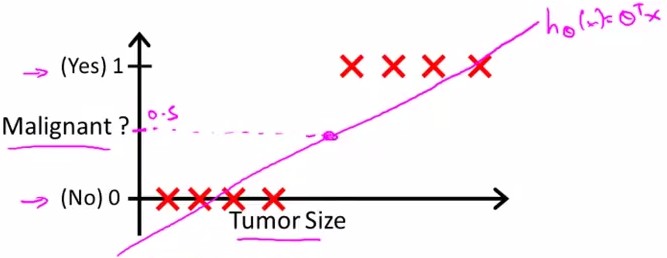
假设进行linear regression得到的hypothesis线性方程如上图中粉线所示,则可以确定一个threshold:0.5进行predict
y=1, if h(x)>=0.5
y=0, if h(x)<0.5
即malignant=0.5的点投影下来,其右边的点预测y=1;左边预测y=0;则能够很好地进行分类。
那么,如果数据集是这样的呢?

这种情况下,假设linear regression预测为蓝线,那么由0.5的boundary得到的线性方程中,不能很好地进行分类。因为不满足
y=1, h(x)>0.5
y=0, h(x)<=0.5
这时,我们引入logistic regression model:

所谓Sigmoid function或Logistic function就是这样一个函数g(z)见上图所示
当z>=0时,g(z)>=0.5;当z<0时,g(z)<0.5
由下图中公式知,给定了数据x和参数θ,y=0和y=1的概率和=1

/*****************************(三)、decision boundary**************************/
所谓Decision Boundary就是能够将所有数据点进行很好地分类的h(x)边界。
如下图所示,假设形如h(x)=g(θ0+θ1x1+θ2x2)的hypothesis参数θ=[-3,1,1]T, 则有
predict Y=1, if -3+x1+x2>=0
predict Y=0, if -3+x1+x2<0
刚好能够将图中所示数据集进行很好地分类

Another Example:

answer:

除了线性boundary还有非线性decision boundaries,比如
下图中,进行分类的decision boundary就是一个半径为1的圆,如图所示:

/********************(四)~(五)Simplified cost function and gradient descent<非常重要>*******************/
该部分讲述简化的logistic regression系统中how to implement gradient descents for logistic regression.
假设我们的数据点中y只会取0和1, 对于一个logistic regression model系统,有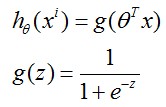 ,那么cost
function定义如下:
,那么cost
function定义如下:
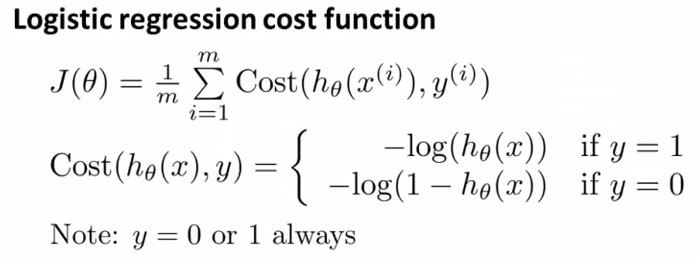
由于y只会取0,1,那么就可以写成

不信的话可以把y=0,y=1分别代入,可以发现这个J(θ)和上面的Cost(hθ(x),y)是一样的(*^__^*) ,那么剩下的工作就是求能最小化 J(θ)的θ了~

在第一章中我们已经讲了如何应用Gradient Descent, 也就是下图Repeat中的部分,将θ中所有维同时进行更新,而J(θ)的导数可以由下面的式子求得,结果如下图手写所示:

现在将其带入Repeat中:
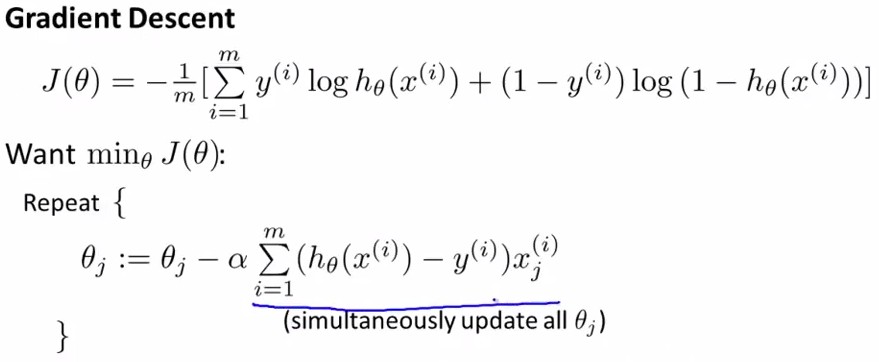
这是我们惊奇的发现,它和第一章中我们得到的公式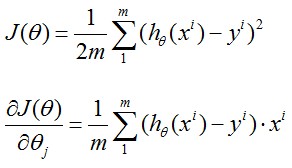 是一样滴~
是一样滴~
也就是说,下图中所示,不管h(x)的表达式是线性的还是logistic regression model, 都能得到如下的参数更新过程。
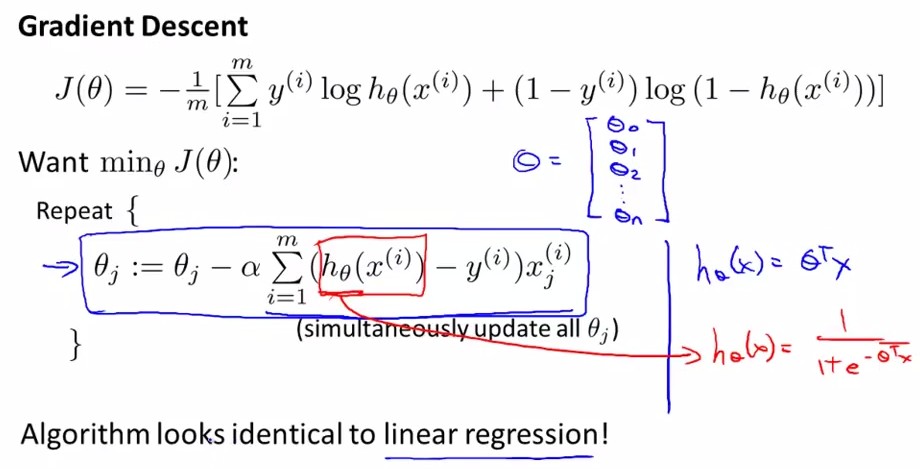
那么如何用vectorization来做呢?换言之,我们不要用for循环一个个更新θj,而用一个矩阵乘法同时更新整个θ。也就是解决下面这个问题:
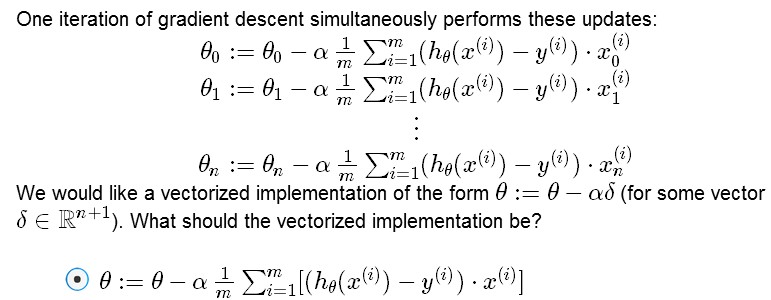
上面的公式给出了参数矩阵θ的更新,那么下面再问个问题,第二讲中说了如何判断学习率α大小是否合适,那么在logistic regression系统中怎么评判呢?
Q:Suppose you are running gradient descent to fit a logistic regression
model with parameter
A:
/*************(六)、Parameter Optimization in Matlab***********/
这部分内容将对logistic regression 做一些优化措施,使得能够更快地进行参数梯度下降。本段实现了matlab下用梯度方法计算最优参数的过程。
首先声明,除了gradient descent 方法之外,我们还有很多方法可以使用,如下图所示,左边是另外三种方法,右边是这三种方法共同的优缺点,无需选择学习率α,更快,但是更复杂。

也就是matlab中已经帮我们实现好了一些优化参数θ的方法,那么这里我们需要完成的事情只是写好cost function,并告诉系统,要用哪个方法进行最优化参数。比如我们用‘GradObj’, Use the GradObj option to specify that FUN also returns a second output argument G that is the partial derivatives of the function df/dX, at the point X.
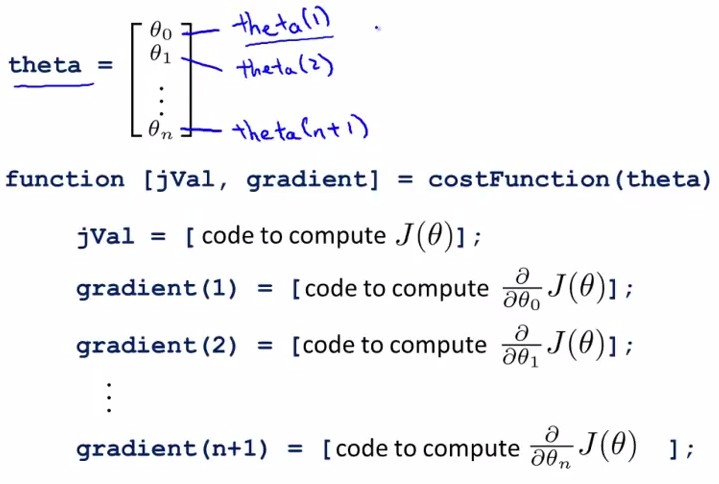
如上图所示,给定了参数θ,我们需要给出cost Function. 其中,
jVal 是 cost function 的表示,比如设有两个点(1,0,5)和(0,1,5)进行回归,那么就设方程为hθ(x)=θ1x1+θ2x2;
则有costfunction J(θ): jVal=(theta(1)-5)^2+(theta(2)-5)^2;
在每次迭代中,按照gradient descent的方法更新参数θ:θ(i)-=gradient(i),其中gradient(i)是J(θ)对θi求导的函数式,在此例中就有gradient(1)=2*(theta(1)-5), gradient(2)=2*(theta(2)-5)。如下面代码所示:
函数costFunction, 定义jVal=J(θ)和对两个θ的gradient:
- function [ jVal,gradient ] = costFunction( theta )
- %COSTFUNCTION Summary of this function goes here
- % Detailed explanation goes here
- jVal= (theta(1)-5)^2+(theta(2)-5)^2;
- gradient = zeros(2,1);
- %code to compute derivative to theta
- gradient(1) = 2 * (theta(1)-5);
- gradient(2) = 2 * (theta(2)-5);
- end
编写函数Gradient_descent,进行参数优化
- function [optTheta,functionVal,exitFlag]=Gradient_descent( )
- %GRADIENT_DESCENT Summary of this function goes here
- % Detailed explanation goes here
- options = optimset('GradObj','on','MaxIter',100);
- initialTheta = zeros(2,1)
- [optTheta,functionVal,exitFlag] = fminunc(@costFunction,initialTheta,options);
- end
matlab主窗口中调用,得到优化厚的参数(θ1,θ2)=(5,5),即hθ(x)=θ1x1+θ2x2=5*x1+5*x2
- [optTheta,functionVal,exitFlag] = Gradient_descent()
- initialTheta =
- 0
- 0
- Local minimum found.
- Optimization completed because the size of the gradient is less than
- the default value of the function tolerance.
- <stopping criteria details>
- optTheta =
- 5
- 5
- functionVal =
- 0
- exitFlag =
- 1
最后得到的结果显示出优化参数optTheta=[5,5], functionVal = costFunction(迭代后) = 0
/*****************************(七)、Multi-class Classification One-vs-all**************************/
所谓one-vs-all method就是将binary分类的方法应用到多类分类中。
比如我想分成K类,那么就将其中一类作为positive,另(k-1)合起来作为negative,这样进行K个h(θ)的参数优化,每次得到的一个hθ(x)是指给定θ和x,它属于positive的类的概率。
按照上面这种方法,给定一个输入向量x,获得最大hθ(x)的类就是x所分到的类。
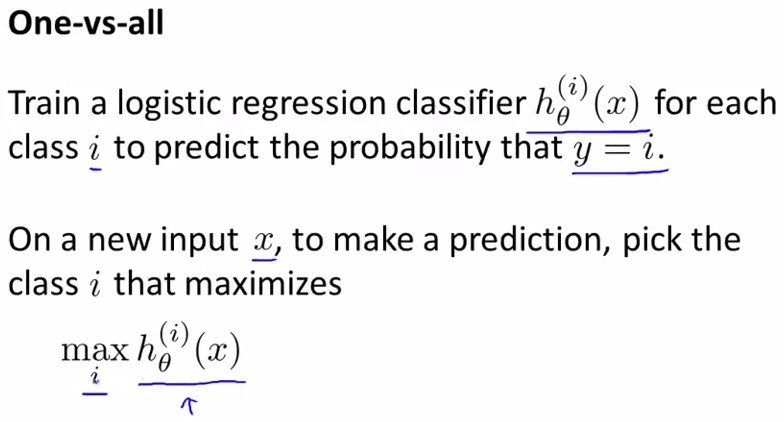
第二部分:The problem of overfitting and how to solve it
/************(八)、The problem of overfitting***********/
The Problem of overfitting:
overfitting就是过拟合,如下图中最右边的那幅图。对于以上讲述的两类(logistic regression和linear regression)都有overfitting的问题,下面分别用两幅图进行解释:
<Linear Regression>:
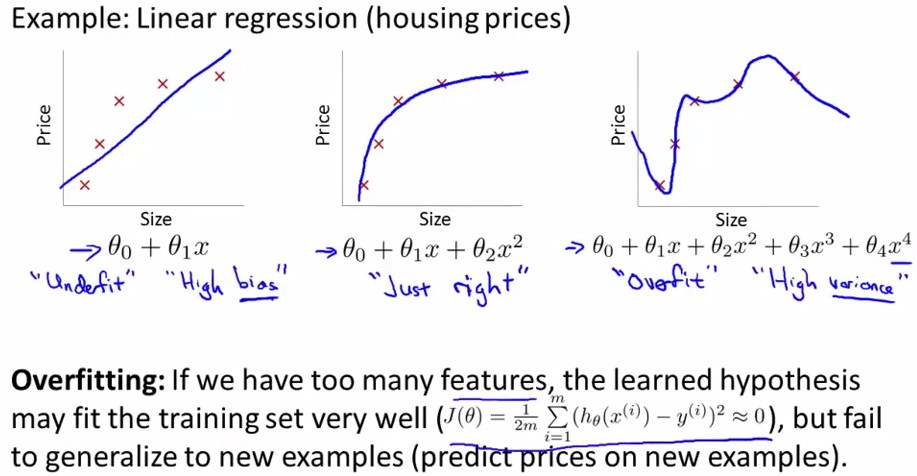
<logistic regression>:
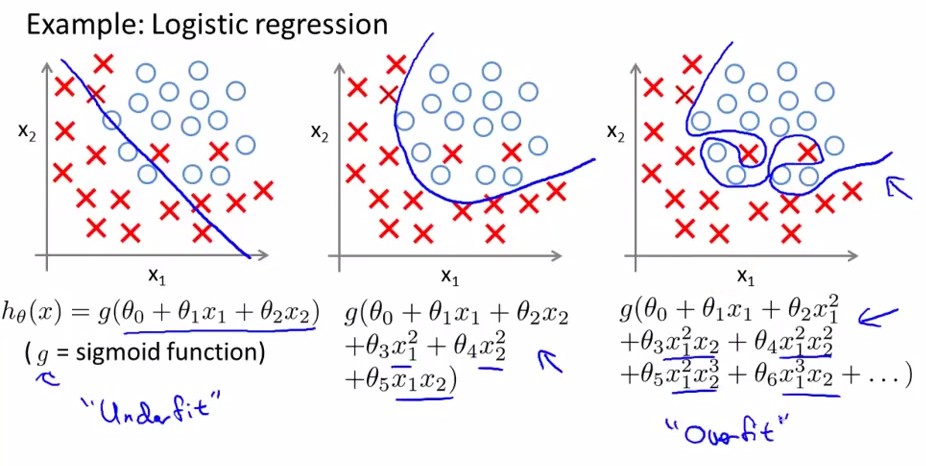
怎样解决过拟合问题呢?两个方法:
1. 减少feature个数(人工定义留多少个feature、算法选取这些feature)
2. 规格化(留下所有的feature,但对于部分feature定义其parameter非常小)
下面我们将对regularization进行详细的讲解。
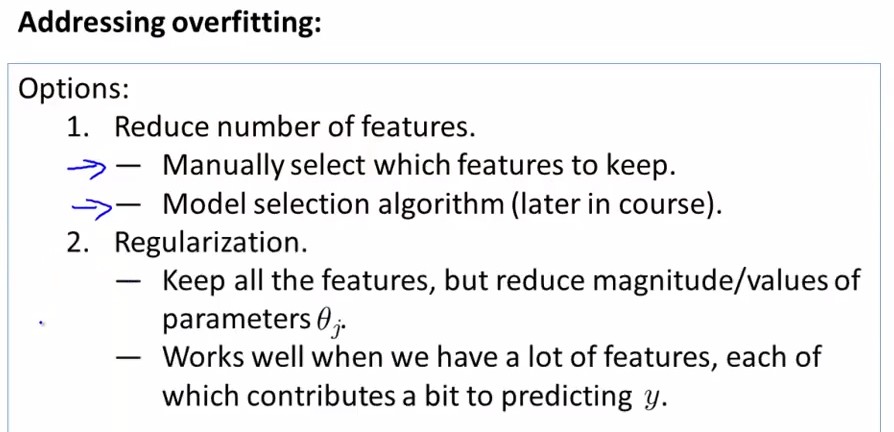
对于linear regression model, 我们的问题是最小化
写作矩阵表示即
i.e. the loss function can be written as
there we can get:
After regularization, however,we have:

写作公式如下,在cost function中加入θ1~θn的惩罚项:
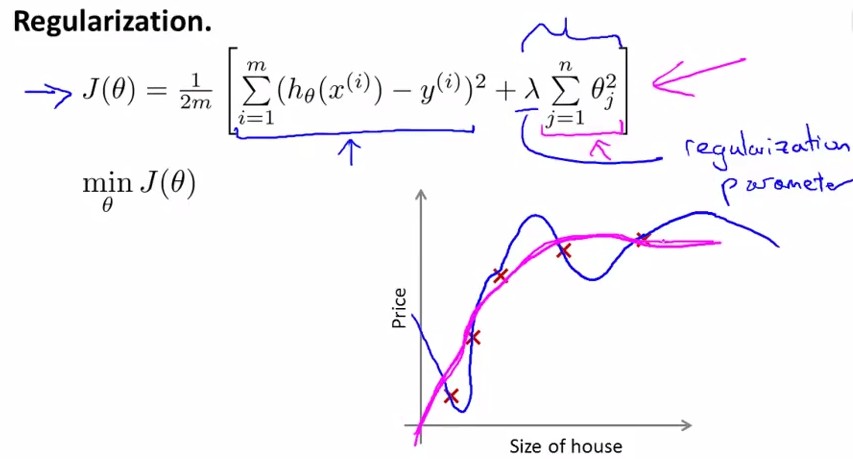
这里要注意λ的设置,见下面这个题目:
Q:
A:λ很大会导致所有θ≈0
下面呢,我们分linear regression 和 logistic regression分别进行regularization步骤.
/************(十)、Regularized Linear Regression***********/
<Linear regression>:
首先看一下,按照上面的cost function的公式,如何应用gradient descent进行参数更新。
对于θ0,没有惩罚项,更新公式跟原来一样
对于其他θj,J(θ)对其求导后还要加上一项(λ/m)*θj,见下图:
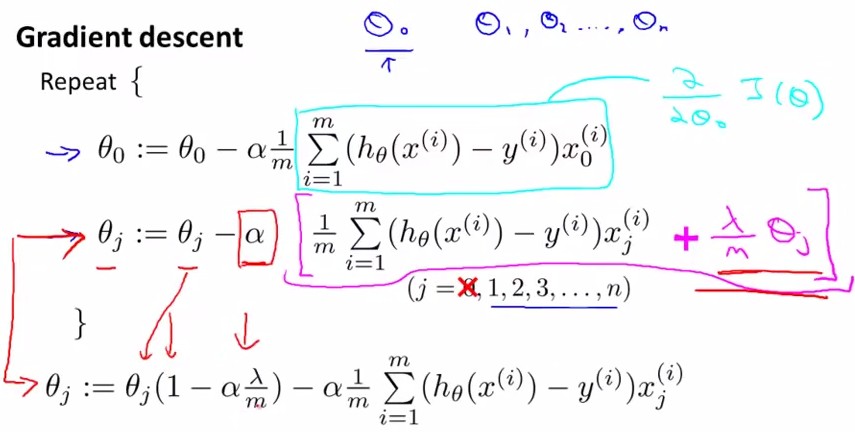
如果不使用梯度下降法(gradient descent+regularization),而是用矩阵计算(normal equation)来求θ,也就求使J(θ)min的θ,令J(θ)对θj求导的所有导数等于0,有公式如下:

而且已经证明,上面公式中括号内的东西是可逆的。
/************(十一)、Regularized Logistic Regression***********/
<Logistic regression>:
前面已经讲过Logisitic Regression的cost function和overfitting的情况,如下图中所示:
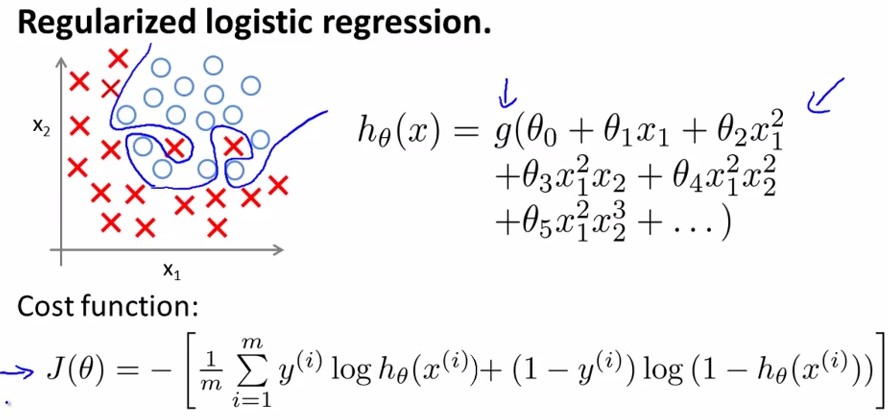
和linear regression一样,我们给J(θ)加入关于θ的惩罚项来抑制过拟合:

用Gradient Descent的方法,令J(θ)对θj求导都等于0,得到
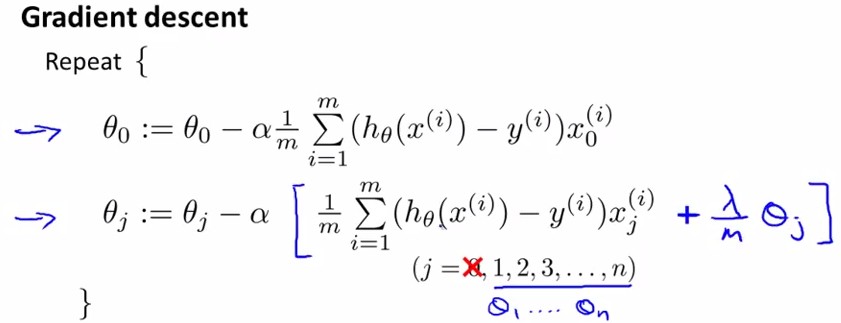
这里我们发现,其实和线性回归的θ更新方法是一样的。
When using regularized logistic regression, which of these is the best way to monitor whether gradient descent is working correctly?

和上面matlab中调用那个例子相似,我们可以定义logistic regression的cost function如下所示:

图中,jval表示cost function 表达式,其中最后一项是参数θ的惩罚项;下面是对各θj求导的梯度,其中θ0没有在惩罚项中,因此gradient不变,θ1~θn分别多了一项(λ/m)*θj;
至此,regularization可以解决linear和logistic的overfitting regression问题了~


